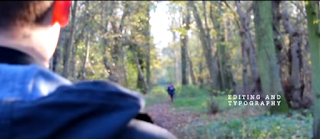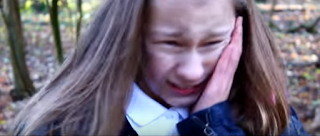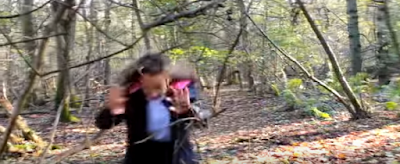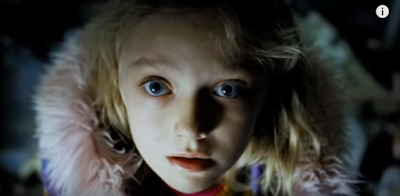Question
2 – How does your media product represent particular social groups?
There are two main
characters in our thriller, the first being the adult antagonist, who little is
revealed about during the opening, other than what their intentions are. While
the antagonist is crucial in advancing the thriller, arguably the more important
character is the child, who is portrayed as the innocent victim that sparks the
rest of the film’s events. By portraying our protagonist as a victim, the
audience is compelled as to who will become the new protagonist following the
killing, creating enigmas almost immediately in our production. We used a child
for the protagonist role, as it allows the target audience of young adults, who
may have young children of their own, to relate to the events happening in the
film, which creates more emotion and suspense. The audience may have heard of
such kidnappings and child murders occurring elsewhere, and actually seeing it
physically play out on a screen enhances emotion. For the role of a child, we
made sure to select a specific age and gender to suit the role. The age of the
child was 12, and was a girl. Female children are stereotypically seen as more
vulnerable and frightened, and the age of the child is just old enough for them
to be aware of the true danger of the situation they find themselves in. The character
wears typical school children’s clothes; commonly worn by nearly all children
of the same age, which serves the purpose of appearing no different to any
other child, and that it could be any child in this situation, including the
audience’s own children that go to school, wearing similar uniforms. School
uniforms also act as a flashback to the viewer of a time of purity and
innocence, stimulating emotion even further in our target audience.
For our antagonist, the
decision was made to have a young adult male, which was made because many of
the target audience may be of the same age as the antagonist, further allowing
them to relate to our thriller. The character wears all black clothing to
connote danger. We made sure to make the
clothing of the antagonist obvious by having it very visible during the few
shots he appears. Intentionally, the focus is on the character’s clothing
rather than their face.

This forces the audience to recognise the character’s
appearances, making it obvious the type of character they are to be and who the
antagonist in the film is. Leaving out the character’s face means the audience
cannot focus on an identity, but only the fact that we have an antagonist
present in the thriller. This allows the audience to recognise the antagonist’s
presence when he appears later in the film, but his identity will still remain
hidden, further shrouding our thriller in mystery and enigma. To achieve this,
we replicated once again the thriller Se7en, in which the antagonist’s face is
not revealed, yet it is made obvious through editing, the shots and the sound
that there is in fact an antagonist on the screen.
We used various unique and
different camera shots throughout our opening to infer various levels of
danger. The initial opening shots, which depict a dual narrative, serves the
purpose of creating a sense of foreboding, as the camera switches from the
killer plotting to the child walking in a long, panning shot, to establish the
location and to infer that this location is where the act of murder will
commence.
Wooded areas are usually seen as potentially dangerous, since you are
mostly out of sight and cannot be heard, so by including as the very first shot
of the child, the audience are immediately privy to the information that the child
is in significant danger. Following this, close up shots of both the
protagonist and antagonist’s feet are displayed, to create a sense of
inevitable peril for the child, while still shrouding the identity of both
characters.
While it is indicated that both characters are in the same place,
we only find this out to be true through an over the shoulder shot, showing the
antagonist standing and viewing the child running away. This shot portrays to
the audience the hopelessness of the protagonist’s situation, as by standing
still and not chasing after the child, it is denoted that the antagonist has
the situation well under control, and is calm.

Having the child running further
deeper into the darker woods rather than away from it was the intentional use
of colour symbolism in our shots. Earlier, in the tracking shot of the child,
the sun is shining brightly over the child, whereas in the over the shoulder
shot, it is clear that the gap where the sun can shine through the wood is
narrowing, suggesting a climax, creating tension for the audience. In this same
over the shoulder shot, the almost parallel line of trees connotes that the
protagonist is trapped, with only one pathway to follow. Having the child
running in this shot suggests panic and disorientation, which is supported in
later shots. This is a stark comparison to the calm demeanour of the
antagonist, whose body language in the few shots shown of him remains relaxed
throughout.
Another shot suggesting vulnerability and the inevitable demise of the protagonist
is the perspective shot, which shows a distorted vision suggesting panic and
fear. This suggests not only panic but also a physical incapability to continue
on running away, thus further suggesting that her demise is closing.
This sense
is supported by a following close up shot of the girl’s face, which is bruised
and muddied. This shot is the first detailed shot depicting true fear, allowing
the audience to clearly understand that the child’s chances of escape are
almost hopeless, yet tension still remains seeing as the audience does not yet
know how close to the child the antagonist is.

Make-up wise, the only
significant make-up used in our thriller opening was the creation of the
child’s muddy face after falling down. This was used to suggest to the audience
the desperation of the situation, and to emphasise the pain the child would be
feeling at this point both physically and mentally. The use of a wood as the
primary location serves the purpose of creating an isolated area in which both
the protagonist and antagonist will be completely alone. Due to the secluded
and sheltered nature of woods and forests, it is easily conceivable to the
audience that the child could indeed become lost, which keeps with our theme of
remaining realistic in our thriller. Woods themselves are quite dangerous in
nature, meaning that the inability for the girl to find an escape is also
completely conceivable, as many areas are blocked off due to large branches or
fallen trees.

Characters similar to our
protagonist can be used as both a protagonist and antagonist. There are various
examples of young girls used for both reasons in thriller films. A good example
of a child at a very similar age used as an innocent protagonist is ‘Rachel
Ferrier’ played by Dakota Fanning in the action/sci-fi thriller ‘War of the
Worlds’. Her character is often focused on with close up shots to display
showings of emotion, distress and panic throughout the film, and her clothing
is also very casual and commonly seen worn by many children.

However there are
certainly examples when the portrayal of innocent looking children can be used
to force the audience to let their guard down, only to be surprised when it is
revealed that the character is actually antagonistic. A perfect example of this
is the ‘Grady Daughters’ in the 1980 horror/thriller The Shining. The two young
girls are wearing innocent appearing matching dresses of a soft blue colour,
with pink ribbon tied around their waists. It is only later understood that
these two children haunt the house after being murdered by their father in the
building.
Using innocent-seeming children can provide the perfect twist to
create suspense and drama in certain situations.